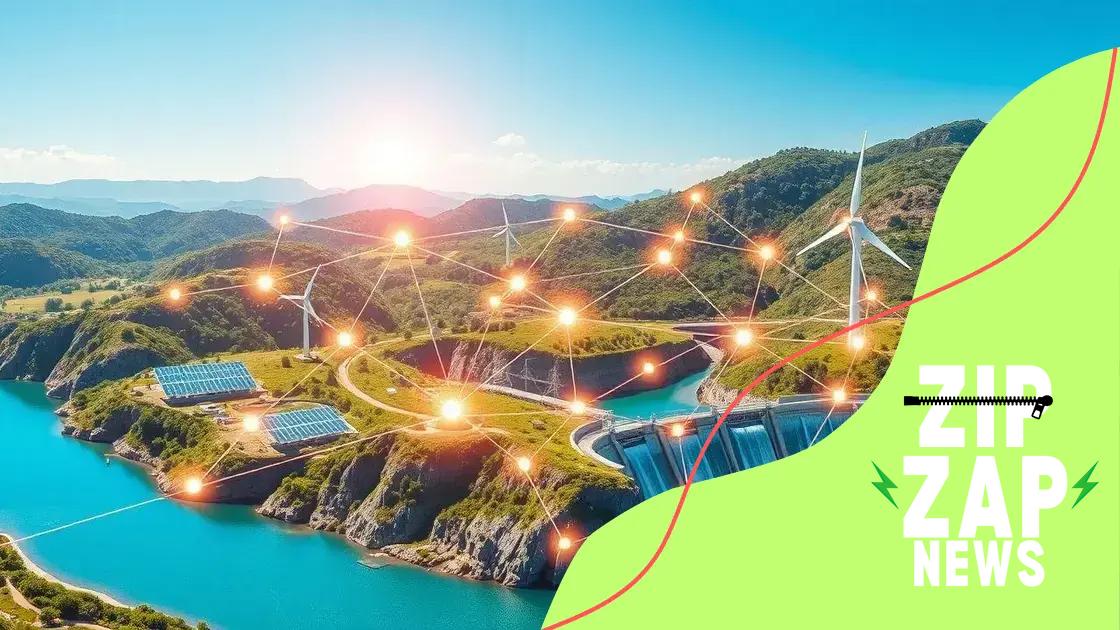Blockchain in renewable energy markets: a transformative approach

Blockchain in renewable energy markets enables secure peer-to-peer trading, enhancing transparency, lowering costs, and supporting a transition to sustainable energy sources while confronting challenges like regulatory uncertainty and technical complexities.
Blockchain in renewable energy markets represents a game-changing opportunity for enhancing sustainability and efficiency. Imagine a system where energy transactions are transparent, traceable, and secure. Intrigued? Let’s delve into how this technology could reshape our energy landscape.
Understanding blockchain technology
Understanding blockchain technology is essential for grasping its impact on various industries, particularly in the realm of renewable energy. At its core, blockchain is a decentralized digital ledger that enables secure, transparent transactions.
This technology allows participants to record transactions in a way that is nearly impossible to alter. Each block in the chain contains a number of transactions, and every time a new transaction occurs, it is added to all participants’ ledgers. This characteristic significantly improves trust among users and reduces the risk of fraud.
Key Features of Blockchain
The key features of blockchain technology include:
- Decentralization: Information is stored across a network of computers rather than on a single server.
- Security: Strong encryption protects data, making unauthorized access difficult.
- Transparency: All transactions are visible to authorized users, ensuring accountability.
- Immutability: Once recorded, information cannot be easily changed or deleted, promoting accuracy.
These features make blockchain particularly appealing for renewable energy markets. For instance, it can facilitate peer-to-peer energy trading, allowing consumers to buy and sell excess energy generated from their solar panels directly without intermediaries.
By integrating blockchain with renewable energy, the overall efficiency of energy distribution can be enhanced. The data captured can also provide insights into energy consumption patterns, helping users make informed decisions and contribute to sustainability efforts.
The potential applications of blockchain technology in renewable energy are vast. For example, it could streamline the process of certifying renewable energy credits, ensuring that they are authentic and traceable. Such innovations can help drive the growth of green energy solutions worldwide.
As we continue to explore this technology, its role in creating a more sustainable and efficient energy future becomes increasingly clear. Understanding these concepts is vital for anyone interested in how blockchain can revolutionize renewable energy markets.
The role of blockchain in renewable energy trading
The role of blockchain in renewable energy trading is becoming increasingly significant as the world moves towards more sustainable energy solutions. This technology enables a decentralized approach to energy trading, allowing consumers to engage directly with one another.
Traditionally, energy trading involves numerous intermediaries, which can lead to inefficiencies and increased costs. However, with blockchain, transactions can be executed swiftly and securely, promoting a more effective market environment.
Benefits of Blockchain in Energy Trading
Blockchain offers several benefits that enhance renewable energy trading. These include:
- Transparency: All transactions are recorded on a public ledger, making it easy for participants to verify and trust each trade.
- Lower Costs: By eliminating middlemen, blockchain reduces transaction fees and costs related to energy trading.
- Increased Efficiency: Smart contracts can automate transactions, significantly speeding up the trading process.
- Empowerment of Consumers: Individuals can sell excess energy generated from renewable sources directly to others, fostering a community-based energy model.
As a result, consumers and producers can negotiate energy prices directly, enabling a more dynamic pricing model. This peer-to-peer trading allows for greater flexibility and responsiveness to market changes.
Moreover, blockchain technology can also facilitate the tracking of renewable energy certificates. This ensures that all traded energy is genuinely renewable, strengthening the market’s integrity. By enhancing the trust in energy certifications, blockchain fosters a more competitive atmosphere for renewable energies.
In summary, the integration of blockchain in renewable energy trading transforms how energy is bought and sold. It opens doors for innovative trading practices that can help achieve sustainability goals while also providing economic benefits.
Benefits of using blockchain in energy markets

Benefits of using blockchain in energy markets are numerous, making this technology a powerful tool for transforming the way energy is traded and managed. One of the main advantages is increased transparency. Blockchain creates a public ledger that records all transactions, so everyone can see and verify trades, which builds trust among participants.
Additionally, blockchain plays a vital role in reducing operational costs. By cutting out middlemen, energy producers and consumers can engage directly, leading to lower transaction fees and faster processing times. This efficiency can significantly benefit the marketplace.
Key Advantages of Blockchain
Some specific benefits of blockchain in energy markets include:
- Enhanced Security: Data on the blockchain is encrypted, making it difficult for hackers to alter information.
- Automation through Smart Contracts: These self-executing contracts automate transactions and ensure terms are met without manual intervention.
- Decentralization: Energy trading shifts from a centralized model to a decentralized network, increasing competition and innovation.
- Improved Demand Response: Blockchain can facilitate real-time transactions, allowing energy supply to adjust quickly to changes in demand.
Moreover, the use of blockchain supports the integration of renewable energy sources. As more people adopt solar panels and wind turbines, blockchain allows these individuals to sell their excess energy directly to consumers without needing a traditional utility company. This shift empowers individuals and promotes a community-oriented energy model.
Blockchain technology also enables better tracking of energy consumption. Participants can analyze their consumption data to achieve energy efficiency and make smarter decisions about their usage. This capability is crucial as we strive for sustainable energy practices.
In essence, the benefits of blockchain in energy markets contribute to a more efficient, secure, and transparent system, paving the way for major advancements in renewable energy adoption and trade.
Challenges faced by blockchain integration
Challenges faced by blockchain integration in the renewable energy sector are significant and can hinder widespread adoption. Despite the potential for improved transparency and efficiency, several obstacles must be addressed to effectively implement blockchain technology.
One major challenge is the complexity of technology. Many stakeholders may not fully understand how blockchain works. This lack of knowledge can lead to reluctance in adopting new systems, especially for small businesses or less tech-savvy individuals.
Key Challenges in Blockchain Integration
Some primary challenges include:
- Regulatory Uncertainty: The legal framework surrounding blockchain is still evolving. Many countries do not have clear regulations, making it risky for businesses to invest in this technology.
- Scalability Issues: As more users join the network, maintaining speed and efficiency becomes critical. Current blockchain systems can struggle to handle large amounts of data, which is necessary for energy trading.
- Interoperability: Different blockchain platforms often do not communicate well with each other. This fragmentation can hinder seamless transactions across platforms.
- Energy Consumption: Ironically, while blockchain is promoting renewable energy, some blockchain networks can consume significant amounts of energy themselves, raising concerns about sustainability.
Additionally, there’s a concern regarding the security of data. Even though blockchain is generally secure, vulnerabilities can still exist, especially during network updates or when connecting new devices.
Resistance from traditional energy companies is another barrier. Existing players may feel threatened by decentralized models. They often prioritize stability and may oppose changes that disrupt their current business models.
Overcoming these challenges requires collaboration among stakeholders, including technology developers, energy providers, and regulatory bodies. By working together, they can create solutions that enhance the technology’s applicability and acceptance within the renewable energy market.
Future trends in renewable energy and blockchain
Future trends in renewable energy and blockchain are becoming increasingly important as the need for sustainable solutions grows. The integration of these technologies is expected to revolutionize the energy landscape in the coming years.
One significant trend is the rise of decentralized energy networks. As blockchain facilitates peer-to-peer trading, individuals will have more control over their energy production and consumption. This shift allows consumers to buy electricity directly from their neighbors, promoting community engagement and sustainability.
Key Trends to Watch
Some key trends that may shape the future of this sector include:
- Increased Adoption of Smart Contracts: These automated agreements will streamline transactions, making energy trades more efficient and reducing the risk of human error.
- Integration with IoT Devices: As more homes use connected devices, blockchain will help manage energy flows in real-time, optimizing consumption and reducing waste.
- Expansion of Renewable Energy Sources: With blockchain, tracking the source of energy becomes easier, encouraging the use of solar, wind, and other renewable resources.
- Enhanced Consumer Empowerment: Consumers will have more access to data about their energy usage, enabling them to make informed decisions about energy management.
Moreover, the connection between renewable energy and blockchain could enable the development of innovative financial models. For instance, energy producers could tokenize their output, allowing them to sell it as digital assets. This approach may open new revenue streams and investment opportunities.
As regulatory environments evolve, governments are likely to incentivize the use of blockchain for energy solutions. Policies might support the creation of green energy certificates that are recorded on the blockchain, ensuring authenticity and traceability.
Overall, the integration of blockchain technology into the renewable energy market holds the potential for transformative changes, encouraging efficiency, sustainability, and consumer participation. Future developments will likely continue to break down traditional barriers, creating a more resilient and adaptable energy ecosystem.
FAQ – Frequently Asked Questions about Blockchain in Renewable Energy
What is the role of blockchain in renewable energy markets?
Blockchain enables secure and transparent peer-to-peer energy trading, allowing consumers to buy and sell energy directly.
What are the main benefits of using blockchain technology?
Benefits include enhanced transparency, reduced costs, increased consumer empowerment, and improved efficiency in energy transactions.
What challenges does blockchain face in the energy sector?
Challenges include regulatory uncertainty, technical complexities, scalability issues, and resistance from traditional energy companies.
How does blockchain promote sustainability?
By facilitating renewable energy trading and tracking energy sources, blockchain contributes to a cleaner environment and enables greater use of green energy.





